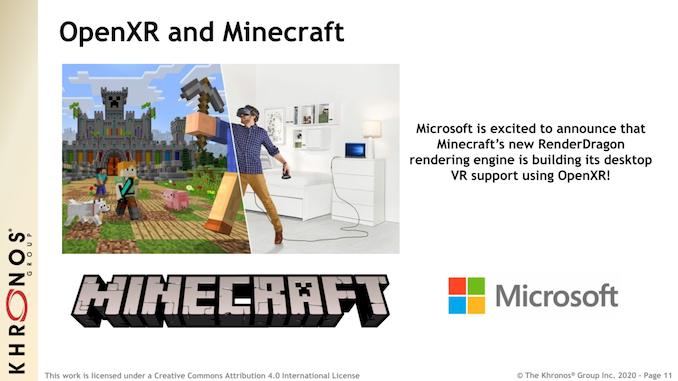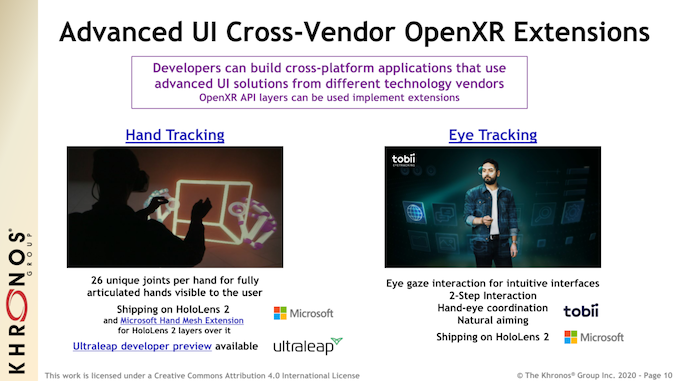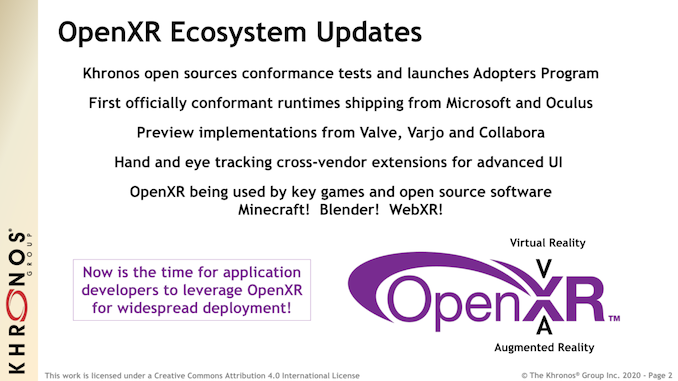OpenXR Update: First Approved Runtimes Now Available, OpenXR Coming to Minecraft
by Ryan Smith on July 28, 2020 9:00 AM EST
Among the many technologies to come under the purview of the Khronos consortium have been augmented reality and virtual reality. Looking to fulfill the group’s mandate to develop open standards for new technologies, the group set about creating an open API for use with AR and VR devices, which culminated in the OpenXR standard. The initial version of that standard was released last summer, and now that the wider technology industry has finally had a chance to develop software for it, this morning Khronos is offering a status update on the state of OpenXR, along with a few choice announcements relating to projects using the new API.
First and foremost, Khronos is announcing that the first standard-conformant implementations for OpenXR are finally shipping. Starting today, both Oculus’s and Microsoft’s respective OpenXR runtimes have passed conformance testing and have been approved by the group, allowing the two companies to promote their support for OpenXR as part of Khronos’s OpenXR adopters program.
Surprisingly, both tethered and stand-alone headsets are among the newly-compliant devices. Both Microsoft and Oculus now have approved runtimes for Windows, bringing OpenXR support to Windows Mixed Reality devices along with the Oculus Rift family of HMDs. Meanwhile Oculus’s stand-alone, Android-powered headset, the Oculus Quest, has also received OpenXR support, as has Microsoft’s stand-alone HoloLens 2 AR headset. This means that in the span of a year OpenXR support has already expanded to cover the full gamut of devices OpenXR was envisioned for, with both AR and VR devices now supporting the API.
This in turn marks a major milestone for OpenXR, as it means the standard has finally resolved the bootstrapping problem that all new APIs face. With working hardware available, rank and file software developers can finally write software and test against actual devices, making the entire process much easier. Consequently, in many ways it’s this moment, rather than last year’s OpenXR 1.0 launch, that truly kicks off the lifecycle for the API, as Khronos and its members can finally reach out to developers about widespread deployment. Meanwhile, the ranks of supported headsets is slated to grow over the coming months, as Valve, Varjo, and Collabora all have OpenXR implementations currently under development.
Speaking of Valve, the game developer and increasingly ecosystem builder as well has previously announced that it is working to transition its own VR wares to OpenXR. Last month the company launched beta support for OpenXR within SteamVR, allowing SteamVR games to use compliant OpenXR runtimes. Meanwhile Valve is essentially putting development of its own OpenVR standard on hold, shifting its focus to OpenXR as any new SteamVR features are slated to be developed against Khronos’s API.
Meanwhile Microsoft is slated to be using OpenXR for some of its own projects as well, most notably a new VR version of Minecraft. Being announced today, Microsoft is adding VR support to the new RenderDragon engine, which was launched earlier this year as part of Minecraft’s ray tracing-enabled graphical overhaul. The new VR implementation will replace the older implementation, which was built against the game’s previous rendering engine and only supported Oculus and Windows MR devices.
Finally, Khronos is also offering a brief update on the state of hand and eye tracking within OpenXR. Neither of these features made it into the core 1.0 specification, but both are now being developed as cross-vendor extensions. Both of these features are up and running on the HoloLens 2, and while developers can already use them today, anyone planning on sticking to the core specification will be happy to hear that Khronos is planning to adopt these extensions into a future version of the core specification once the extensions have proven their worth.
Source: Khronos




















15 Comments
View All Comments
jordanclock - Tuesday, July 28, 2020 - link
I'm assuming if Microsoft is jumping aboard, then OpenXR works with DirectX and doesn't require the games/apps to be ported to OpenGL. The OpenXR spec has one mention of DirectX and it is phrased as if DirectX is supported.Ryan Smith - Tuesday, July 28, 2020 - link
Yes. OpenXR is independent of the graphics API used.FreckledTrout - Tuesday, July 28, 2020 - link
I hope the open standards from the likes of Kronos keep gaining ground. We have had way to much proprietary stuff in the GPU world from API's, random Nvidia fixed functions, and even freaking monitor solution's. This densest need to repeat for VR.edzieba - Tuesday, July 28, 2020 - link
Things are working the same way they did for Sound and 3D APIs: Multiple vendors produce multiple proprietary APIs to match the varying featuresets of their devices. After a few years and everyone getting a good feel for what features are universally needed, which are not, and what ways to interact with them work best, /then/ you can get everyone together and start to hash out a multi-vendor standard.Premature standardisation from trying to jump past the prodcuct development portion of the lifecycle just leaves you with a 'standard' utilised by nobody due to its inadequacy.
darkswordsman17 - Tuesday, July 28, 2020 - link
I hope not! Audio languished because of Creative Labs' monopoly that was gained via patents, which forced Microsoft to rework audio entirely, and now we've got a giant mixed bag of stuff with no real clear path towards neat stuff like object based audio formats; Sony's path tracing based 3D audio for the PS5 sounds interesting but we'll see if it gains any real traction). Also, I hope people know that Creative basically controls OpenAL (making it not that open, hence why its not even that popular). Heck, even Creative has been rolling through a mix of that stuff (THX, DD Live, etc). They're even dabbling back in proprietary stuff (they have some new surround processing thing). The whole thing was and still is a mess. We should've had dedicated path tracing audio chips that would enable object based audio that could be automatically tailored to your equipment and layout (EQ room correction for instance), even your specific hearing capabilities.edzieba - Tuesday, July 28, 2020 - link
I'm talking about way back before the whole Aureal thing. To the time where games had you select your sound hardware before starting so that you could get any sound /at all/ because there was no standard audio interface. Today, when was the last time you've started a game and ever had to even consider the possibility that you wouldn't hear any audio?abufrejoval - Wednesday, July 29, 2020 - link
all the time, all the time...My main machine has audio via display port, but also on-board.
I am alternating between two USB connected headsets (remote work!), one of which also offers a disconncted mode over Bluetooth as well as a USB web cam.
It's running virtual machines, Steam Remote Play and Terminal Services.
It comes to 12 audio outputs and 9 inputs.
It's a miracle if audio just work with five different sets of video conferencing software...
Mr Perfect - Tuesday, July 28, 2020 - link
The Blender support is really interesting. Being able to create 3D models in a 3D space? That's got to be amazing.martinw - Tuesday, July 28, 2020 - link
I've done some modelling in VR, and while it is amazing, it is also tiring. Being able to walk around and through your model and tweak it is great, but after a while your arms just start getting tired.Zingam - Tuesday, July 28, 2020 - link
Clicker kids these days complaining about some physical activity! Imagine Michelangelo hammering stone all day long!